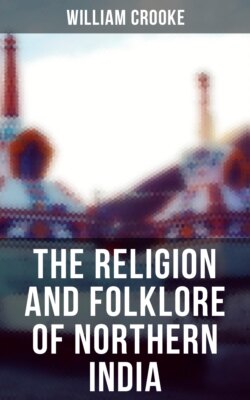Читать книгу The Religion and Folklore of Northern India - William Crooke - Страница 17
На сайте Литреса книга снята с продажи.
Star-worship.
ОглавлениеTable of Contents
The worship of the other constellations is much less important than those of the greater luminaries which we have been discussing. The Hindu names nine constellations, known as Nava-graha, “the nine seizers,” specially in reference to Râhu, which grips the sun and moon in eclipses, and more generally in the astrological sense of influencing the destinies of men. These nine stars are the sun (Sûrya), the moon (Soma, Chandra), the ascending and descending nodes (Râhu, Ketu), and the five planets—Mercury (Budha), Venus (Sukra), Mars (Mangala, Angâraka), Jupiter (Vrihaspati), and Saturn (Sani). This group of nine stars is worshipped at marriages and other important religious rites. Of the signs of the Zodiac (râsi-chakra) the rural Hindu knows little more than the names—Mesha (Aries), Vrisha (Taurus), Mithuna (Gemini), Karka (Cancer), Sinha (Leo), Kanya (Virgo), Tula (Libra), Vrischika (Scorpio), Dhanu (Sagittarius), Makara (Capricornus), Kumbha (Aquarius), and Mîna (Pisces). Practically the only direct influence they exercise over his life is that from the opening Râsi or sign in which he is born the first letter of the secret name which he bears is selected. Still less concern has he with the asterisms or Nakshatra, a word which has been variously interpreted to mean “coming or ascending,” “night guardians,” or “undecaying.” As already stated, they are said to have been the twenty-seven daughters of the Rishi Daksha, and wives of Soma or the moon. The usual enumeration gives twenty-eight, and they are vaguely supposed to represent certain stars or constellations, but the identification of these is very uncertain. One list, with some of the corresponding stars, gives Sravishthâ or Dhanishthâ (Delphinus), Sata-bhishaj (Aquarius), Pûrva Bhâdrapadâ, Uttara Bhâdrapadâ, Revatî, Asvinî (Aries), Bharanî (Musca), Krittikâ (the Pleiades), Rohinî (Aldebaran), Mriga-siras (Orion), Ârdrâ, Punarvasû, Pushya, Âsleshâ, Maghâ (Leo), Pûrvâ-Phalgunî, Uttara Phalgunî, Hasta (Corvus), Chitrâ (Spica Virginis), Svâtî (Arcturus), Visâkha (Libra), Anurâdhâ, Jyeshthâ, Mûla, Pûrva Âshâdhâ, Uttara Âshâdhâ, Abhijit (Lyra), and Sravana. These are used only in calculating the marriage horoscope, and the only one of them with which the fairly well-to-do rustic has much concern is with the unlucky Mûla. Should by an evil chance his son be born in this asterism, he has to undergo a most elaborate rite of purification.
Others stars have their legends. The Riksha or constellation of the Great Bear represents the seven deified Rishis—Gautama, Bhâradwaja, Viswamitra, Jamadagni, Vashishtha, Kasyapa and Atri. Dhruva, the Pole Star, was the grandson of Manu Swayambhuva, and was driven from his home by his step-mother. He, though a Kshatriya, joined the company of the Rishis and was finally raised to the skies as Grahadhâra, “the pivot of the plants.” So Canopus is the Rishi Agastya who was perhaps one of the early Aryan missionaries to Southern India and won a place in heaven by his piety. Orion is Mrigasiras, the head of Brahma in the form of a stag which was struck off by Siva when the deity attempted violence to his own daughter Sandhyâ, the twilight. Krittikâ or the Pleiades represent the six nurses of Kârttikeya, the god of war.
Part of the purificatory rite for a woman after her delivery is to bring her out at night and let her look at the stars, while her husband stands over her with a bludgeon to guard her from the assaults of demons. One interesting survival of the old mythology is that in Upper India women are fond of teaching their children that the stars are kine and the moon their shepherd, an idea which has formed the basis of much of the speculations of a school of comparative mythology now almost completely discredited.
